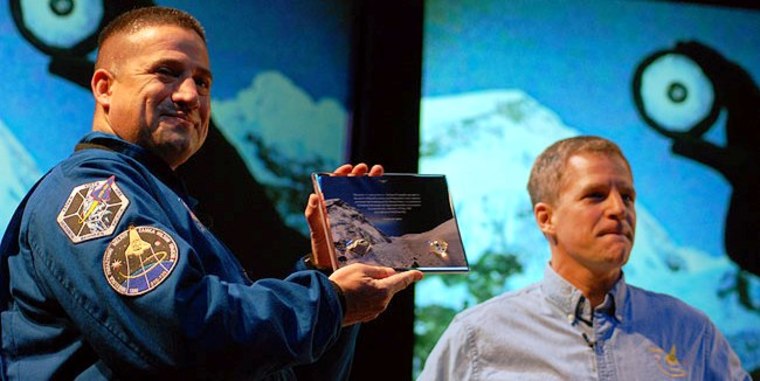Two small rock samples — one from the top of our world and the second returned from another world — are ready to launch to the International Space Station as a symbol of NASA's continuing mission to explore.
The space-bound stones — a fragment of Mount Everest's summit and four flecks from the moon — were presented Wednesday to George Zamka, the commander of NASA's next space shuttle mission, by the first astronaut to scale Earth's highest mountain, Scott Parazynski.
"These rocks have already done more than a human being could do in a lifetime," Zamka said during a ceremony conducted at Space Center Houston, the public visitor center for NASA's Johnson Space Center in Texas. "For 4 billion years they were on the moon, undisturbed. They went through an ascent on a spaceship traveling to Earth, and then Scott took them to the limits of human endurance by climbing up with them on Mount Everest. So they already have a tremendous history. They're about to get a mileage upgrade."
"When they go on the space station," he continued, "they are going to travel at 17,500 miles an hour for a number of years. They are going to have a tremendous trip."
Parazynski personally retrieved the Everest rock when he reached the 29,000-foot mountain's peak on May 20, 2009, while carrying four fragments of the moon collected by Neil Armstrong and Buzz Aldrin during the first U.S. lunar landing mission 40 years earlier.
"These little samples were collected literally worlds apart," Parazynski told CollectSpace.com. "But there are other worlds for us to go explore, and [the space station crews] are going to be a part of it."
Zamka, who with his STS-130 crewmates are scheduled to launch to the space station aboard the space shuttle Endeavour on Feb. 7, will install the rock samples inside the Cupola, a window-studded viewing port attached to the new module they are adding to the outpost. Named "Tranquility" for the Apollo 11 site where the lunar crumbs were retrieved, the module will house the station's life support systems.
Returns and repeats
This isn't the first time that fragments of Everest and the moon have flown to the space station, though it is the first mission on which they have flown together.
NASA secretly stowed a 21-gram lunar rock, also brought back to Earth by the Apollo 11 crew, aboard the shuttle Discovery in March 2009 as part of the agency's 40th-anniversary celebration for the first lunar landing. The moon rock floated aboard the orbiting outpost for a few months, during which time it starred in a video downlinked from the station. Then it was brought back to Earth — but not before being scheduled for another flight.
NASA pledged to fly the rock back to the moon on its first mission to return humans to the lunar surface, a symbolic gesture that hearkened back to 1972 and the Apollo 16 mission that delivered an Apollo 12-collected rock back to the moon as part of a science experiment.
The moon rocks that Parazynski toted up Everest and are to fly with STS-130 — four small chips that together weigh just 0.05 grams — were originally encased in acrylic for another symbolic purpose, as a goodwill gift. By order of then-President Richard Nixon, approximately 250 similar button displays were created in late 1969 to be distributed to the U.S. possessions and states as well as 135 foreign nations. The set that is now bound for the station was left over from that original allocation.
Historical precedents
It was another nation, Canada, which brought the first piece of Everest to the space station. In September 2006, STS-115 mission specialist and Canadian Space Agency astronaut Steven MacLean flew a pebble from "the top of the world" that had been retrieved by Canadian mountaineer Bernard Voyer in May 1999.
MacLean, who in 2008 became president of the Canadian Space Agency, returned the Everest rock to Voyer in April 2007.
At least one other piece of the peak has flown to space. A rock collected in 1963 during the first ascent of the West Ridge of Mount Everest flew on the shuttle Columbia with the personal items of mission specialist and medical doctor James Bagian during the STS-40 mission in 1991.
Parazynski, who like Bagian has a medical degree, gave NASA a rock he collected during his second attempt to reach Everest's summit. His first climb a year earlier in 2008 ended early when he suffered a back injury.
The NASA-prepared plaque to which both the moon rocks and Mount Everest rock were attached for their flight to space includes an inscription dedicating their journey with Parazynski to "honor explorers and heroes Neil Armstrong and Sir Edmund Hillary," the first men to walk on the moon and to summit Everest, respectively.
the story at CollectSpace.com to learn more about the rocks' mission to challenge space explorers and to see more photos from the handover ceremony.
